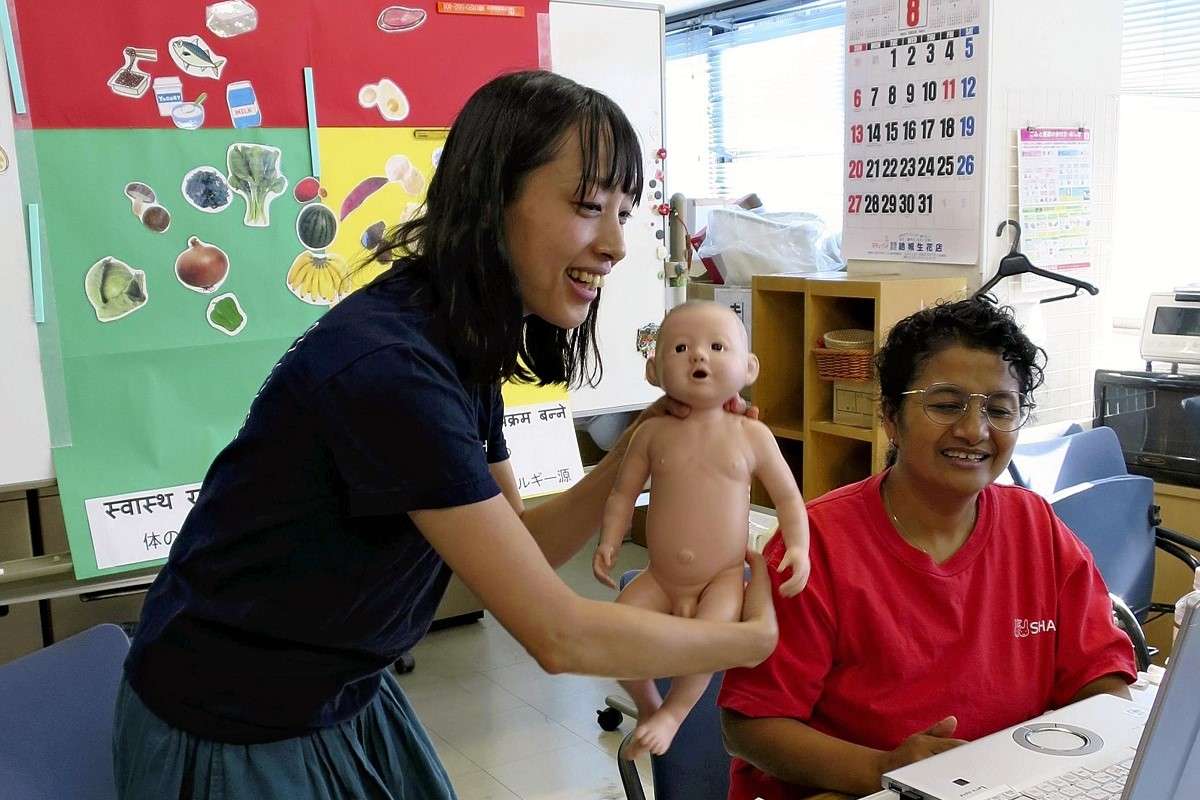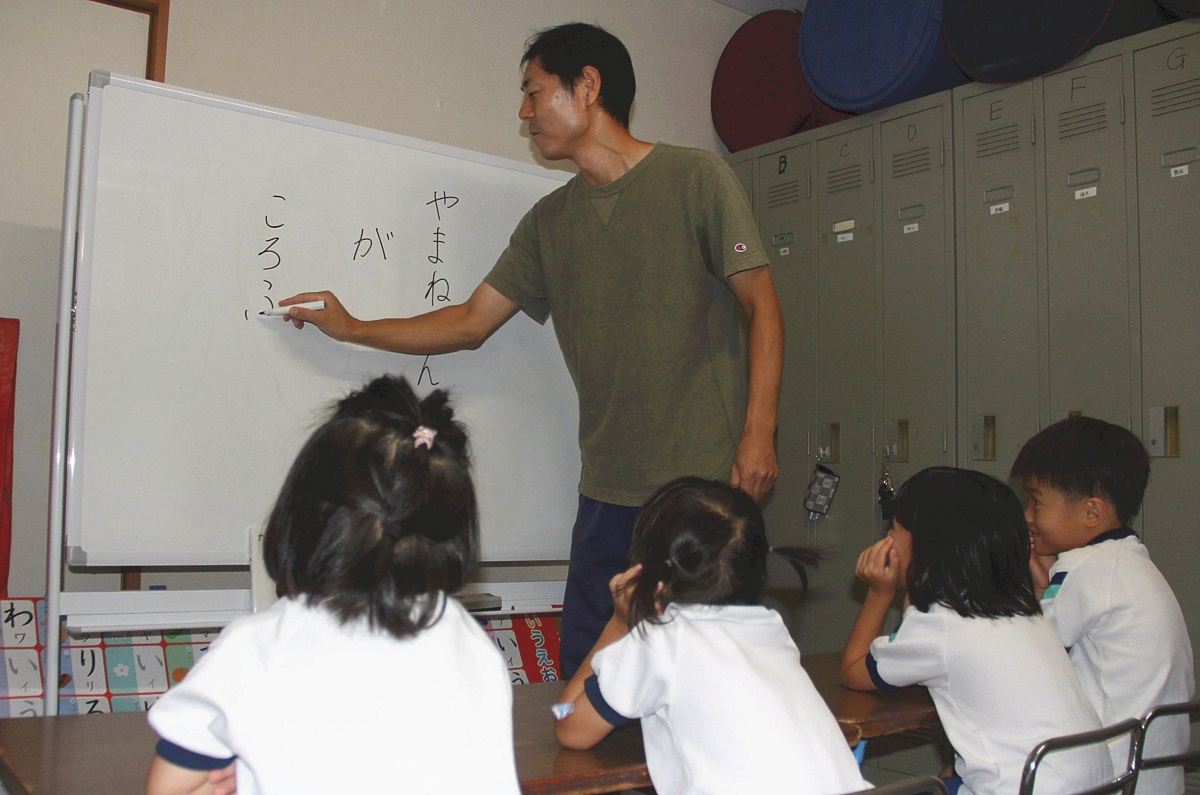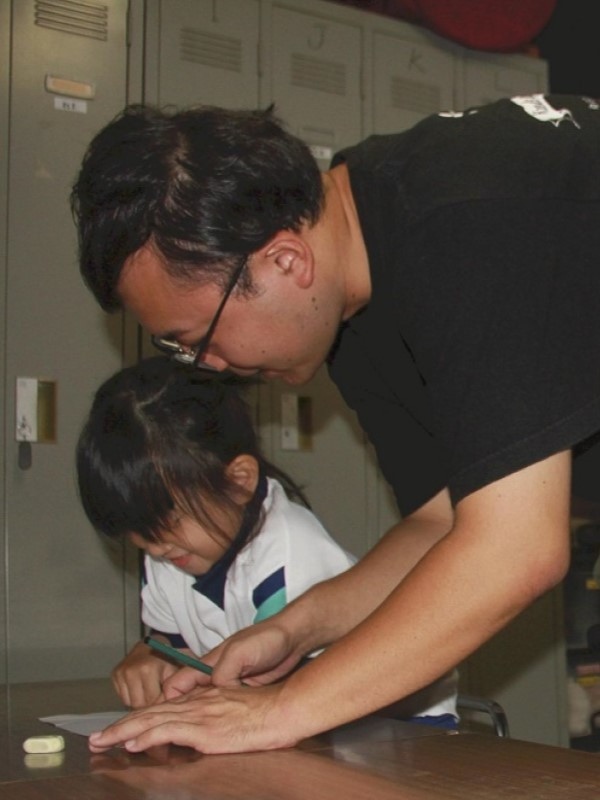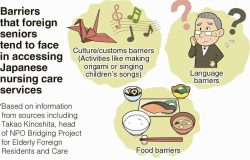
Pregnant foreigners learn Japanese words useful at hospitals and other places at a lecture in Toshima Ward, Tokyo.
12:59 JST, December 18, 2023
As more foreigners take up residence in Japan, the challenges facing those giving birth and raising children, arising from differences in culture, religion and lifestyle, make it important that support be provided. Language often becomes a barrier to obtaining essential information. Stories below describe activities that have helped foreign women and their children overcome such obstacles.
***
In September, Yuki Ashimura, a naturalized Japanese born in Indonesia, gave birth to her second child in Japan.
Unlike in Indonesia, where women can choose to have a C-section, the 39-year-old was puzzled by the fact that natural childbirth is the norm in Japan, and that few hospitals offer anesthesia to ease the pain.
Reflecting on her own experience, Ashimura thought, “I want to help people who feel uneasy,” and she became a volunteer at an organization that helps smooth the way for non-native mothers in Japan.
The nonprofit Mother’s Tree Japan has been providing support for foreign nationals from the pregnancy stage to child-rearing since June 2020. The organization is based in Tokyo’s Toshima Ward, of which 10% of residents are foreign nationals.
Mother’s Tree has 30 volunteers, including foreigners with experience raising children in Japan, providing counseling in six languages including Chinese and Thai. They also accompany mothers on hospital visits and help with administrative procedures.
The system allows mothers-to-be to get help from someone from their own country who has gone through prenatal exams and infant health checks, and can lend an ear to hear their concerns about raising a child.
So far, the organization has provided consultations for more than 1,700 people. Pregnant women denied treatment by hospitals because of their inability to speak Japanese have been helped to find one where they can give birth. The group also helps out with residence visa and financial issues.
The organization offers lectures on pregnancy and child-rearing, with the foreign volunteers providing translations. At one lecture in September, about 20 people, including pregnant women from four countries, learned how to express their physical condition in Japanese, being taught such words as “tsuwari” (morning sickness) and “oshirushi” (bleeding that indicates the baby is coming).
Myat Phyo Han, a 34-year-old pregnant woman from Myanmar, said that she found the course helpful because communication at the hospital has been difficult.
She took the class with her husband, also a Myanmar native, and made friends who taught her how to call a taxi when her contractions start and about other matters.
“The anxiety about pregnancy gets even stronger when the woman is in another country,” said Tomomi Tsubonoya, the secretary general of Mother’s Tree. “They have no one to talk to, and some of them suffer from postpartum depression. They need a system that reduces anxiety and keeps them from feeling alone.”
Different customs
Sometimes it is a matter of explaining the difference in customs, as a midwife with another nonprofit organization explained during an online lecture for Nepalese pregnant women in August.
“In Japan, it is very humid and a baby’s skin is prone to rashes, so we bathe them every day,” said Saori Matsuo of the nonprofit Share, based in Taito Ward, Tokyo, as a Nepalese volunteer did the interpreting.
In Nepal, oil massage is used in the care of babies, while a daily bath is customary in Japan.
Japan has seen a recent influx in the number of Nepalese for study or for a government-sponsored technical intern training program for foreigners. The majority of pregnant Nepalese in Japan have accompanied their husbands, and rarely understand Japanese.
Share’s aim is to provide support by ensuring the women get information on childbirth and childcare in their native language.
***
Foreign population at new high

A midwife and interpreter give an online lecture for pregnant Nepalese in Taito Ward, Tokyo.
According to the Immigration Services Agency, the number of foreigners living in Japan at the end of last year was about 3.07 million, the most ever on record.
By country or region, 80% were from Asia, led by China with about 760,000, Vietnam (about 490,000) and South Korea (about 410,000).
With the government continuing to look into its policy for allowing in foreign nationals, the number is expected to increase in the future.
There are also many foreigners giving birth in Japan. According to the government’s vital statistics on population, there were 18,435 children of foreign nationality born in Japan in 2021, a 60% increase from 10 years earlier.
Including babies with one foreign and one Japanese parent, the total reached 34,660, or one out of every 24 children born in Japan.
Meanwhile, there have been cases of technical intern trainees being told by their employers that they will be asked to return home if they become pregnant. Such threats have led some to conceal their pregnancies and abandon their newborn babies, making it vital that this sector of foreign residents also be provided support.
***
Nursery schools step up support for children with foreign parents

Children learn Japanese at Ikuno Komorebi nursery school in Osaka.
Efforts are being made at childcare facilities to support children who are non-Japanese or whose parents have foreign nationality.
Nursery schools provide lessons to teach children to read Japanese aloud in preparation for entering elementary school. Differences in eating habits for religious reasons are also taken into consideration and the establishments keep in close contact with parents to ensure children can grow up healthy and happy.
“Heigh-ho, heave-ho. Still, the turnip does not come out.”
In late September, a group of 18 children read aloud from the book “Okina Kabu” (The big turnip) at Ikuno Komorebi nursery school in Ikuno Ward, Osaka City. The children are set to enter elementary school next April.
The ward has about 27,000 foreign residents, the largest number in Osaka. Many of the children at the nursery school have parents from Vietnam, South Korea and China: Of the 100 children enrolled, 60% are either non-Japanese, or have a foreign parent.
As the number of Vietnamese residents has increased over the past few years, the nursery school began teaching Japanese in spring. Classes are held once a week to read aloud from textbooks for arithmetic and Japanese that are used in first-grade elementary school classes. Children who are not proficient in reading aloud are also taught how to write hiragana and katakana.
“We want the children to acquire a habit of learning Japanese,” said Keiko Tsujimoto, 72, the head of the nursery school.
If the children learn as much Japanese as possible during this period, they will be able to keep up with elementary school classes and enjoy playing with their peers, she said.
When teaching Japanese at daycare facilities, it is important to ensure that the children do not forget their native language.
“We don’t want to interfere with the children’s ability to communicate with their families by overburdening them with Japanese,” Tsujimoto said.
In April, the nursery school hired a 23-year-old Vietnamese woman as a childcare staff member and interpreter. As many parents are not fluent in Japanese, the staff member keeps in close contact with families by translating and distributing event schedules in Vietnamese. The documents are also made available in Korean and Chinese.
School lunches

Children learn how to write hiragana at Ikuno Komorebi nursery school in Okasa in September.
Differences in eating customs are also an issue at nursery schools. Staff members need to understand the religious backgrounds of the children, so communication with parents is especially important.
In 2020, the Yokkaichi municipal government in Mie Prefecture issued halal guidelines for school lunches at nursery schools and other institutions so meals are prepared in accordance with Islamic rules. The policy was made after a school in the city served pork to a child with a Muslim background without sufficiently consulting with their parents.
The guidelines require staff to have a proper understanding of halal standards. In the case of a child from a Muslim family enrolling in the school, the guidelines clearly state that the school will listen to the parents’ requests during an interview and inform them of possible accommodations. In principle, pork can be excluded and forbidden seasonings can be changed. However, families who request stricter measures, such as separate cooking utensils, will be allowed to prepare their own lunch boxes.
"JN Specialities" POPULAR ARTICLE
-

The Japan News / Weekly Edition (12/12-12/18)
-

English-language Kabuki, Kyogen Entertain Audiences in Tokyo; Portland State University Professor Emeritus, Graduates Perform
-

Noodle Dining Shunsai / Rich Oyster Ramen to Savor at Odasaga; Experienced 68-year-old Owner Creates Numerous Ramen Varieties
-

The Japan News / Weekly Edition (12/5-12/11)
-

People Keep Loved Ones’ Ashes Close in Special Jewelry, Small Urns as Unique Way to Memorialize Them
JN ACCESS RANKING
-

Keidanren Chairman Yoshinobu Tsutsui Visits Kashiwazaki-Kariwa Nuclear Power Plant; Inspects New Emergency Safety System
-

Imports of Rare Earths from China Facing Delays, May Be Caused by Deterioration of Japan-China Relations
-

Tokyo Economic Security Forum to Hold Inaugural Meeting Amid Tense Global Environment
-

University of Tokyo Professor Discusses Japanese Economic Security in Interview Ahead of Forum
-

Japan Pulls out of Vietnam Nuclear Project, Complicating Hanoi’s Power Plans

























